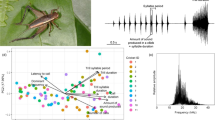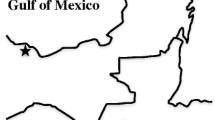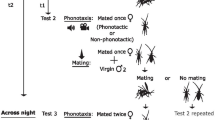Abstract
Sex differences in metabolic rate (MR) can result from dimorphism in the performance of energetically demanding activities. Male crickets (Teleogryllus oceanicus) engage in costly calling and aggressive activity not performed by females. Consistent with this difference, we found higher maximal MR, factorial scope, and fat content in males than females. T. oceanicus song is also costly because it attracts the parasitoid fly Ormia ochracea. Parasitized crickets had reduced maximal MR consistent with a metabolic cost to harboring larvae. This cost was greater for females, either because females invest more heavily into reproduction at the expense of metabolic capacity, or because males are under stronger selection to respond to infection. Little is known about O. ochracea outside of its auditory system and parasitic lifestyle. We observed greater resting MR in male flies, possibly reflecting a sex difference in the requirement for metabolic power output, because male flies perform potentially costly mating behavior not seen in females. We found a positive relationship between larval density within a cricket and pupal resting MR, suggesting that crickets in good condition are able to both harbor more larvae and produce larvae with higher resting MR. These results reveal a complex interplay between the metabolism of crickets and their fly parasitoids.




Similar content being viewed by others
References
Adamo SA, Robert D, Hoy RR (1995a) Effects of a tachinid parasitoid, Ormia ochracea, on the behaviour and reproduction of its male and female field cricket hosts (Gryllus spp). J Insect Physiol 41:269–277
Adamo SA, Robert D, Perez J, Hoy RR (1995b) The response of an insect parasitoid, Ormia ochracea (Tachinidae), to the uncertainty of larval success during infestation. Behav Ecol Sociobiol 36:111–118
Adamo SA (1999) Evidence for adaptive changes in egg laying in crickets exposed to bacteria and parasites. Anim Behav 57:117–124
Alcock J, Smith AP (1995) Landmark-defense and scramble competition mating systems in two Australian tachinid flies (Diptera). J Kansas Entomol Soc 68:85–94
Alekseeva TA, Zotin AI, Yasyukevich VV, Sidorova NV (1993) Oxygen uptake by adult forms of the Diptera. Izv Ross Akad Nauk 3:426–435
Alleyne M, Chappell MA, Gelman DB, Beckage NE (1997) Effects of parasitism by the braconid wasp Cotesia congregata on metabolic rate in host larvae of the tobacco hornworm, Manduca sexta. J Insect Physiol 43:143–154
Belshaw R (1994) Life history characteristics of Tachinidae (Diptera) and their effect on polyphagy. In: Hawkins BA, Sheehan W (eds) Parasitoid community ecology. Oxford University Press, Oxford, pp 145–162
Burk T (1983) Male aggression and female choice in a field cricket (Teleogryllus oceanicus): the importance of courtship song. In: Gwynne DT, Morris GK (eds) Orthopteran mating systems: sexual competition in a diverse group of insects. Westview, Boulder, Colorado, pp 97–119
Cade WH (1975) Acoustically orienting parasitoids: fly phonotaxis to cricket song. Science 190:1312–1313
Cade WH (1984) Genetic variation underlying sexual behavior and reproduction. Am Zool 24:355–366
Chappell MA, Morgan KR (1987) Temperature regulation, endothermy, resting metabolism, and flight energetics of tachinid flies (Nowickia sp.). Physiol Zool 60:550–559
Chappell MA, Zuk M, Johnsen TS (1996) Repeatability of aerobic performance in red junglefowl: effects of ontogeny and nematode infection. Funct Ecol 10:578–585
Dahlman DL, Herald F (1971) Effects of the parasite, Apanteles congregatus, on respiration of tobacco hornworm, Manduca sexta larvae. Comp Biochem Physiol A 40:871–880
Godfray HCJ (1994) Parasitoids: behavioral ecology and evolutionary ecology. Princeton University Press, Princeton, New Jersey
Hack MA (1997a) The energetic costs of fighting in the house cricket, Acheta domesticus L. Behav Ecol 8:28–36
Hack MA (1997b) The effects of mass and age on standard metabolic rate in house crickets. Physiol Entomol 22:325–331
Hinds DS, Baudinette RV, MacMillen RE, Halpern EA (1993) Maximum metabolism and the aerobic factorial scope of endotherms. J Exp Biol 182:41–56
Hofmann HA, Schildberger K (2001) Assessment of strength and willingness to fight during aggressive encounters in crickets. Anim Behav 62:337–348
Honek A (1993) Intraspecific variation in body size and fecundity in insects: a general relationship. Oikos 66:483–492
Hunt J, Allen GR (2000) Larval density and developmental instability in the acoustically orienting parasitoid Homotrixa alleni. Acta Ethol 2:129–132
Kolluru GR, Zuk M (2001) Parasitism patterns and the size-fecundity relationship in the acoustically orienting dipteran parasitoid Ormia ochracea. Can J Zool 79:973–979
Kolluru GR, Zuk M, Chappell MA (2002) Reduced reproductive effort in male field crickets infested with parasitoid fly larvae. Behav Ecol 13:607–614
Krasnov BR, Burdelov SA, Khokhlova IS, Burdelova NV (2003) Sexual size dimorphism, morphological traits and jump performance in seven species of desert fleas (Siphonaptera). J Zool Lond 261:181–189
Krasnov BR, Khokhlova IS, Burdelov SA, Fielden LJ (2004) Metabolic rate and jump performance in seven species of desert fleas. J Insect Physiol 50:149–156
Lederhouse RC, Morse RA, Ambrose JT, Burgett DM, Conner WE, Edwards L, Fell RD, Rutowski R, Turell M (1976) Crepuscular mating aggregations in certain Ormia and Sitophaga. Ann Entomol Soc Am 69:656–658
Morgan KR (1987) Temperature regulation, energy metabolism and mate-searching in rain beetles (Pleocoma spp.), winter-active, endothermic scarabs (Coleoptera). J Exp Biol 128:107–122
Moulin B, Rybak F, Aubin T, Jallon J-M (2001) Compared ontogenesis of courtship song components of males from the sibling species, D. melanogaster and D. simulans. Behav Genetics 31:299–308
Müller CB, Fritsche F (1993) Unequal costs of parasitism for male and female lygaeid bugs. J Insect Behav 6:265–269
Müller P, Robert D (2001) A shot in the dark: the silent quest of a free-flying phonotactic fly. J Exp Biol 204:1039–1052
Murray A-M, Cade WH (1995) Differences in age structure among field cricket populations (Orthoptera; Gryllidae): possible influence of a sex-biased parasitoid. Can J Zool 73:1207–1213
Odell JP (1998) Energetics of metamorphosis in two holometabolous insect species: Manduca sexta (Lepidoptera: Sphingidae) and Tenebrio molitor (Coleoptera: Tenebrionidae). J Exp Zool 280:344–353
Prestwich KN (1994) The energetics of acoustic signaling in anurans and insects. Am Zool 34:625–643
Reinhold K (1999) Energetically costly behaviour and the evolution of resting metabolic rate in insects. Funct Ecol 13:217–224
Reznick DN, Braun V (1987) Fat cycling in the mosquitofish (Gambusia affinis): fat storage as a reproductive adaptation. Oecologia 73:401–413
Rivers DB, Denlinger DL (1994) Redirection of metabolism in the flesh fly, Sarcophaga bullata, following envenomation by the ectoparasitoid Nasonia vitripennis and correlation of metabolic effects with the diapause status of the host. J Insect Physiol 40:207–215
Roff D (1977) Dispersal in dipterans: its costs and consequences. J Animal Ecol 46:443–456
Rogowitz GL, Chappell MA (2000) Energy metabolism of eucalyptus-boring beetles at rest and during locomotion: gender makes a difference. J Exp Biol 203:1131–1139
SAS Institute (1995) JMP statistics and graphics guide, version 3. SAS Institute, Cary, North Carolina
Sayle MH (1928) The metabolism of insects. Q Rev Biol 3:542–553
Shillington C, Peterson CC (2002) Energy metabolism of male and female tarantulas (Aphonopelma anax) during locomotion. J Exp Biol 205:2909–2914
Simmons LW, Zuk M (1994) Age structure of parasitized and unparasitized populations of the field cricket, Teleogryllus oceanicus. Ethology 98:333–340
Speirs DC, Sherratt TN, Hubbard SF (1991) Parasitoid diets—does superparasitism pay? Trends Ecol Evol 6:22–25
Vinson SB (1990) How parasitoids deal with the immune system of their host: an overview. Arch Insect Biochem Physiol 13:3–27
Zuk M, Simmons LW, Cupp L (1993) Calling characteristics of parasitized and unparasitized populations of the field cricket Teleogryllus oceanicus. Behav Ecol Sociobiol 33:339–343
Zuk M, Simmons LW, Rotenberry JT (1995) Acoustically-orienting parasitoids in calling and silent males of the field cricket Teleogryllus oceanicus. Ecol Entomol 20:380–383
Zuk M, Simmons LW, Rotenberry JT, Stoehr AM (2004) Sex differences in immunity in two species of field crickets. Can J Zool 82:627–634
Acknowledgements
We are grateful to J.T. Rotenberry for assistance with field measurements, L.P. Nunney, D. Price and D.N. Reznick for allowing us to use their laboratory facilities, and the University of Hawaii, Hilo groundskeeping staff for their assistance in the field. This research was supported by the University of California at Riverside Intramural Funds to M.A.C. M.Z. is supported by grants from the US National Science Foundation and the UCR Academic Senate. The experiments comply with the current laws of the USA.
Author information
Authors and Affiliations
Corresponding author
Additional information
Communicated by G. Heldmaier
Rights and permissions
About this article
Cite this article
Kolluru, G.R., Chappell, M.A. & Zuk, M. Sex differences in metabolic rates in field crickets and their dipteran parasitoids. J Comp Physiol B 174, 641–648 (2004). https://doi.org/10.1007/s00360-004-0455-z
Accepted:
Published:
Issue Date:
DOI: https://doi.org/10.1007/s00360-004-0455-z




